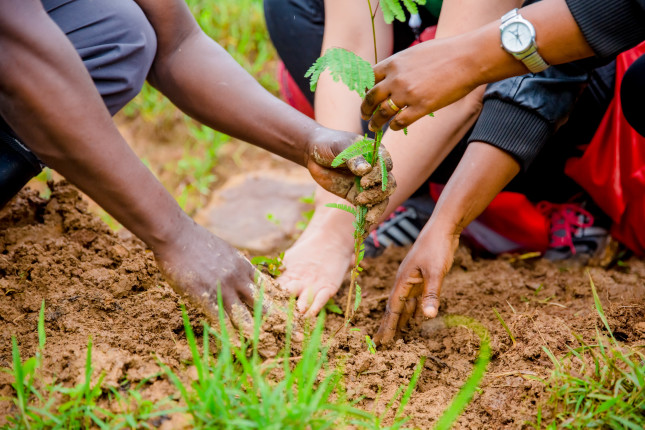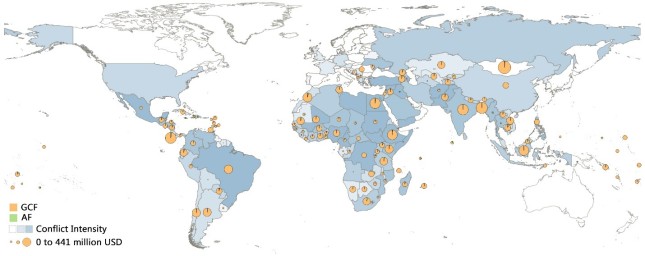-
Climate Finance: Taking Stock of Investments and Opportunities to Sustain Peace
A key pillar of the UNFCCC was a commitment by industrialized nations to cover the incremental cost of climate change mitigation for developing countries. As part of this pledge, they agreed to mobilize $100 billion a year in climate finance by 2020 and maintain that level of funding up to 2025. While there are questions on whether this target has been met, climate finance has undeniably become one of the largest channels of wealth redistribution from developed to developing countries.
Yet, despite the large number of investments that have already been mobilized, there is still a poor understanding of the impact of climate finance on peace and security. This is a crucial gap, especially given that climate funding is increasingly targeting fragile and conflict-affected countries. It is essential that governments, institutions, and policymakers take stock of climate investments in the context of looming crises, and identify critical bottlenecks and opportunities to build and sustain peace.
The risk of conflict blindness
Climate finance involves the mobilization of funds, through private or public means, for activities related to mitigation and adaptation to climate change. The main actors are development institutions, climate-specific funding mechanisms, and green bond issuers. Two of the largest entities operating in this financial landscape are the Green Climate Fund (GCF) and the Adaptation Fund (AF), which have respectively mobilized $10.1 billion and $0.85 billion. Of this total, the majority has been allocated to Africa ($3.4 billion), followed by the Asia-Pacific region ($3.1 billion), and South Asia ($1 billion).
Figure 1: Map of Adaptation Fund and the Green Climate Fund mobilizations. (Source: Armed Conflict Location & Event Data Project.)
Most of the investments of the GCF and AF (as shown in the images above and below) focus on countries that have a history of violent conflict. About $2 billion has been allocated to countries that have reported more than 5,000 deaths from battles, remote violence, or violence against civilians occurring between 2015 and 2021. Some of the recipient countries include states affected by terrorism (Nigeria and Iraq), state violence (Myanmar), political violence (Ethiopia), and international intrastate conflict (Afghanistan). These investments make clear that the operational reality of climate funds is already intertwined with conflict and insecurity dynamics.
Given the nature of the countries where the GCF and the AF invest, one would expect these entities, at a minimum, to have conflict-sensitivity strategies in place. Yet research shows that these organizations are ill-equipped to deal with risks connected to political instability, conflict, and structural violence. Not only do these funds systematically discount risks emerging from political fragility in recipient countries, but they also omit to account for the possibility that their investments can yield undesirable socio-economic consequences, catalyze new grievances, or exacerbate already existing inequalities.
Figure 2: Mobilizations by the AP and GCF in millions of USD. Left: Regional destination. Right: Intensity level of conflict in recipient countries. (Source: Armed Conflict Location & Event Data Project.)
That these two funds possess few tools to deal with aspects related to conflict prevention and resolution (such as policies on gender and Indigenous people, risk frameworks, and redress) is only one problem. Another issue is that they lack a systematic integration of conflict sensitivity across their strategies, policies and investment guidance. This is a particularly problematic situation, because it may expose the funds to operational risks emerging from unforeseen security problems. For example, since conflict management mechanisms are not mainstreamed into the project cycle, the majority of funding proposals submitted to the GCF (including those from conflict-affected countries) have failed to include conflict assessments or contingency plans for the outbreak of conflict.
Last, but not least, is that conflict blindness has also limited the scope of climate funds. Adopting a conflict-sensitive approach would potentially allow funds to better reach those populations that are in urgent need of support while also addressing and mitigating climate-related drivers of conflict at the local-level. Yet this crucial step to guarantee the long-term sustainability of their investments has not yet been made. It is unfortunate that while there are ongoing debates in the UN system on how climate finance can sustain peace, there is still a lack of coordination between climate finance and peacebuilding mandates.
How to Move Forward
Climate finance can be a vast resource to tackle the root causes of vulnerability and prevent conflict. However, to unpack this potential, it is essential to direct funding and investments into countries that are at major risk of climate-related instability. While the allocation of funds for fragile and conflict-affected states (as well as for climate change adaptation) has increased significantly over the past few years, countries and populations most affected by compounded climate and conflict risks are still insufficiently targeted.
Filling in existing data gaps around the interactions between exposure, social vulnerabilities, and conflict risk is crucial to inform international financial institutions, investors, and the private sector. Obtaining this data is also crucial to ease entry barriers to funding for fragile and conflict-affected countries. Moreover, climate investments must go beyond a mere technical understanding of building resilience and include conflict analysis in the design process.
To this end, the SPARC Knowledge initiative recommends flexible operational protocols to accommodate security risks and include beneficiaries and local stakeholders in investment design. Similarly, the Finance 4 Climate Security initiative by CGIAR is developing practical tools for financial institutions to improve their conflict sensitivity and better mobilize climate finance in fragile and conflict-affected areas.
Where climate funds lack the requisite expertise, creating partnerships with research organizations offers a rapid means of knowledge transfer that does not push these organizations to operate beyond their mandate. As researchers and humanitarian-development practitioners increasingly identify how climate change and peacebuilding are interrelated, this dynamic is being addressed by the development of methodologies, tools, and guidelines to operationalize co-beneficial aims both in investment design and deployment. A recent report by the UNDP and the Climate Security Mechanism notes the need for “intentionality in the design process,” and that a climate security lens must be incorporated into fund-level strategic planning.
Another pathway to incorporate conflict governance activities into climate funds is through greater integration and collaboration across peacebuilding and climate-oriented financial agencies. Institutions could seize more opportunities to integrate investments between the UN Secretary-General’s Peacebuilding Fund (PBF) and multilateral climate funds. While climate is still a small part of the PBF’s portfolio, recent investments have been directed to “Preventing Climate-Induced Conflicts Through Empowered Women Leadership” in Papua New Guinea, as well as supporting sustainable peace in Sudan through climate-resilient livelihoods. Perhaps an increased partnership between the PBF and various UNFCCC funds could bring the former’s expertise in peacebuilding to bear on the latter’s substantial capital base.
Across the climate finance and peacebuilding landscapes, the way forward is clear. Complementary expertise and mandates should be leveraged wherever possible to reflect the interrelated nature of climate and conflict in investment design and deployment.
Cesare M. Scartozzi is a researcher and consultant for CGIAR FOCUS Climate Security. He holds a PhD in Public Policy from the University of Tokyo. A list of his publications is available at www.scartozzi.eu.
Adam Savelli is CGIAR FOCUS Climate Security’s Regional Focal Point for Southeast Asia and leader of the Finance 4 Climate Security research initiative. He is based in Hanoi, Vietnam and specializes in climate-related mobilities, adaptation financing, climate security, and climate-smart agriculture.
Giulia Caroli works for CGIAR FOCUS Climate Security, and is currently based in Nairobi, Kenya, where she conducts research and policy work on climate security, climate action and sustaining peace. She holds a master’s degree in International Relations and Diplomatic Affairs from the University of Bologna.
Sources: Armed Conflict Location & Event Data Project; International Peacekeeping; International Studies Review; Research Group Climate Change and Security (CLISE); International Studies Perspectives; SPARC; The Lancet: Planetary Health; United Nations
Photo Credit: Three people planting during the launch of the “Strengthening Climate Resilience of Rural Communities in Northern Rwanda” project in the Gicumbi District funded by the Green Climate Fund, courtesy of flickr user Ministry of Environment – Rwanda.
 A Publication of the Stimson Center.
A Publication of the Stimson Center.






